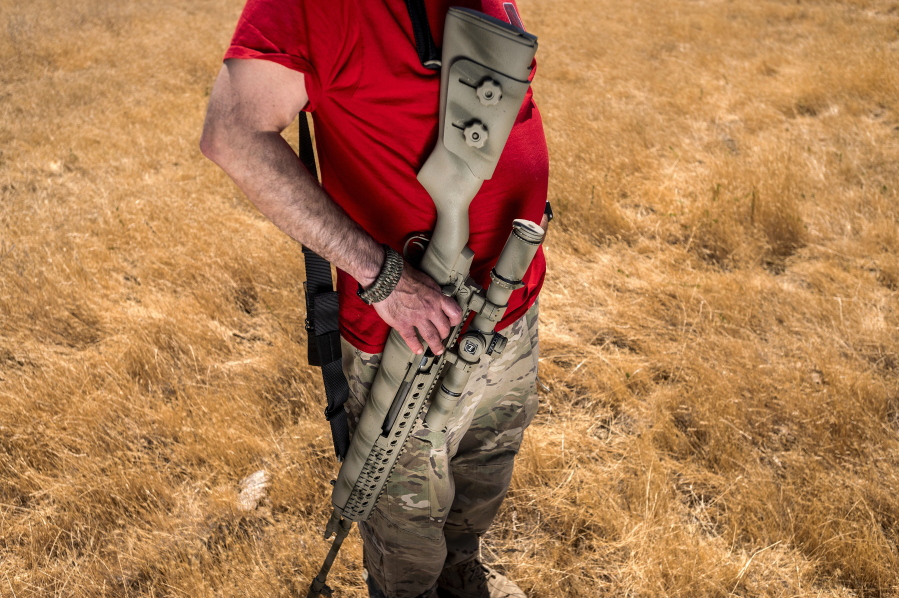Determined to keep track of their guns, some U.S. military units have turned to a technology that could let enemies detect troops on the battlefield, The Associated Press has found.
The rollout on Army and Air Force bases continues even though the Department of Defense itself describes putting the technology in firearms as a “significant” security risk.
The Marines have rejected radio frequency identification technology in weapons for that very reason, and the Navy said that it was halting its own dalliance.
RFID, as the technology is known, is infused throughout daily civilian life. Thin RFID tags help drivers zip through toll booths, hospitals locate tools and supermarkets track their stock. Tags are in some identity documents, airline baggage tags and even amusement park wristbands.
When embedded in military guns, RFID tags can trim hours off time-intensive tasks, such as weapon counts and distribution. Outside the armory, however, the same silent, invisible signals that help automate inventory checks could become an unwanted tracking beacon.
The AP scrutinized how the U.S. armed services use technology to keep closer control of their firearms as part of an investigation into stolen and missing military guns — some of which have been used in street violence. The examination included new field tests that demonstrated some of the security issues RFID presents.
The field tests showed how tags inside weapons can be quickly copied, giving would-be thieves in gun rooms and armories a new advantage.
And, more crucially, that even low-tech enemies could identify U.S. troops at distances far greater than advertised by contractors who install the systems.
Which is why a spokesman for the Department of Defense said its policymakers oppose embedding tags in firearms except in limited, very specific cases, such as guns that are used only at a firing range — not in combat or to guard bases.
“It would pose a significant operations security risk in the field, allowing an adversary to easily identify DOD personnel operating locations and potentially even their identity,” Pentagon spokesman Lt. Col. Uriah Orland told AP.
Spokespeople at the headquarters of the Air Force and Army said they did not know how many units have converted their armories.
AP found five Air Force bases that have operated at least one RFID armory, and one more that plans a retrofit. Executives at military contracting companies said many more units have sought proposals.
A Florida-based Army Green Berets unit, the 7th Special Forces Group, confirmed it uses the technology in “a few” arms rooms. Special forces soldiers can take tagged weapons into the field, said Maj. Dan Lessard, a special forces spokesman. A separate pilot project at Fort Bragg, the sprawling Army base in North Carolina, was suspended due to COVID-19.
The Navy told AP one armory on a base up the coast from Los Angeles was using RFID for inventory. Then last week, after extended questioning, spokesman Lt. Lewis Aldridge abruptly said that the technology “didn’t meet operational requirements” and wouldn’t be used across the service.
Momentum for RFID built within the Air Force after a 2018 case in which a machine gun disappeared from the 91st Security Forces Group, which guards an installation that houses nuclear-tipped missiles. Authorities recovered the weapon, but the incident reverberated across the service.
With Air Force commanders looking to bolster armory security, defense contractors offered a familiar technology, one with a military pedigree.
The origins of RFID trace to World War II and the development of radar. In the U.S. military, use grew in the 1990s, after the first Gulf War showed a need to untangle vast supply chains of shipping containers.
The U.S. military is not alone in employing RFID for firearms management: Government armories in Nigeria, Saudi Arabia and elsewhere have been outfitted.
Armory conversions cost thousands of dollars, and sometimes more. Convenience is a big selling point. Instead of hand-recording firearm serial numbers on paper or scanning barcodes one-by-one like a cashier, an armorer can read tags in a rack of firearms with the wave of a handheld reader — and without having to see each weapon. The tags tucked inside don’t even need batteries.
Contractors that retrofit armories say tags can be read only within a limited range, typically a few dozen feet or less. But in field testing for AP, two prominent cybersecurity experts showed that a tag inside a rifle can be read from significantly farther, using inexpensive components that fit inside a backpack.
While the hackers who devised the experiments observed U.S. government restrictions on transmitting signals, enemies who would not be so constrained could detect tags miles away, they said.



